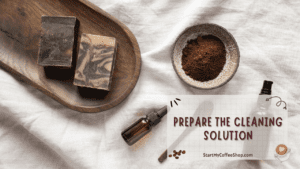Awakening to the inviting aroma of freshly brewed coffee only to find that your coffee pot has been inflicted with charred spots and residue is one of life’s greatest disappointments. The fight to get rid of those obstinate marks has happened to all of us, and it can be frustrating. Do not worry, however, as we have the perfect way to revive your favorite coffee maker and bring it back to its prior dazzling brilliance.
To clean a burnt coffee pot, you should fill it with a mixture of equal parts vinegar and water. Boil the solution and let it sit for about an hour, scrub the pot with a paste of baking soda, then rinse the pot thoroughly, and repeat the process if necessary.
This article describes a natural and effective method for cleaning a burnt coffee machine. Say farewell to burnt coffee pots and say hello to a revitalized coffee-brewing experience that leaves you with nothing but the pure flavor of your preferred morning brew.
Prepare the Cleaning Solution

Gather your cleaning supplies, including white vinegar and water, to begin the cleaning procedure and say goodbye to those stubborn burnt stains. The natural acidity of vinegar acts as a potent agent in breaking down the burnt residue that has taken up residence in your coffee pot. As the vinegar works its magic, the water dilutes the solution, ensuring that it is gentle enough not to damage the interior of your cherished coffee pot.
To achieve the best cleaning effects, keep the vinegar and water in a fair ratio when measuring. The optimal mixture is equal parts vinegar and water, with the amount needed to be determined by the size of your coffee pot. A cup of each should be plenty for a regular 10-cup coffee pot. Adjust the measurements accordingly if you have a larger or smaller coffee pot to obtain the perfect cleaning mixture.
Once you have the appropriate quantities of vinegar and water, you’re ready to embark on the quest to restore the brilliance of your coffee pot. Prepare to be astounded by the transformational power of this simple combination, which easily removes even the most stubborn burnt stains. The vinegar’s acidity acts as a gentle but effective dissolving agent, releasing the burnt-on residues that have collected over time. As the solution works its way into every nook and cranny of the pot’s interior, it breaks down the uninvited charred guests, making them significantly more receptive to removal.
The diluting characteristics of water ensure that the potency of the vinegar is appropriately balanced, ensuring a safe and effective cleaning operation. You won’t have to use harsh chemicals or abrasive scrubbing techniques to clean your coffee pot thanks to this clever combination of vinegar and water. The natural method is not only environmentally beneficial, but it also extends the life of your coffee maker, allowing you to enjoy many more lovely mornings with a freshly brewed cup of coffee.
Read more about: How Much Does it Cost to Start a Coffee Brand: Budgeting Your Coffee Dreams
Boil the Cleaning Solution
Cleaning a coffee pot can be a difficult process, especially if it is soiled with tenacious coffee stains and deposits that appear immune to conventional cleaning methods. There is, however, a simple yet effective remedy that can return your coffee maker to its former glory with no effort.
To begin the cleaning process, make a vinegar and water solution. The acidity of vinegar acts as a natural cleaning agent, making it ideal for removing difficult stains and deposits. Fill the coffee pot halfway with the vinegar and water mixture, making sure to cover the afflicted areas.
Place the coffee pot on the stove with the vinegar and water combination in place and turn on the heat. As the combination gradually warms up, the vinegar’s powerful acetic acid will work its magic, permeating the tough residues that have accumulated over time. The acid and coffee stains begin to react chemically, causing them to loosen and disintegrate.
Allow the solution to come to a steady boil after the heat is turned on. The boiling action speeds up the cleaning process by dislodging and breaking down the coffee stains and deposits. The increasing steam also penetrates the pot’s nooks and crannies, ensuring that every surface is treated.
To ensure thorough cleaning, keep the boiling process going for a few minutes. Depending on the intensity of the stains, you may need to slightly increase the boiling time. However, don’t let the coffee pot boil dry, as this can cause damage.
After the allowed boiling time has gone, carefully remove the coffee pot from the heat and allow it to cool. Once it’s safe to handle, gently clean away any leftover stains and deposits using a gentle brush or cloth. The result is a sparkling clean coffee pot free of the unattractive residues of previous brews.
Let it Sit and Soak
After bringing the vinegar and water solution to a strong boil, the next critical step in the coffee pot cleaning procedure is to remove it from the heat source and leave it alone for about an hour. This seemingly innocuous but critical step in the cleaning process ensures that the vinegar can work its magic on the persistent burnt-on stains that have collected inside the pot over time.
During this time, the cleaning process’s chemistry continues to perform its magic. The vinegar’s acetic acid, which is responsible for its powerful cleaning properties, penetrates deeply into the layers of filth, coffee residues, and stubborn deposits that have attached to the internal surfaces of the coffee pot. As the vinegar soaks into these strong stains, it breaks down their chemical bonds, allowing them to lose their grip on the pot’s walls and base.
The prolonged exposure to vinegar allows it to function more efficiently, dissolving and removing the burnt-on spots. This dissolving action during the pre-treatment step makes the subsequent cleaning step easier and more effective.
Aside from the chemical reactions, the soaking period aids in the physical portion of the cleaning process. The temperature contrast provides a thermal shock to the tenacious stains when the combination cools over the waiting hour. This temperature change might weaken the link between the stains and the coffee pot’s surface, making them easier to remove afterward.
During this hour-long intermission, patience is required, but the benefits are well worth the wait. After the soaking time is passed, the once difficult chore of eliminating burnt-on stains becomes much more manageable. The softened residues simply peel off with a soft brush or cloth, and with a gentle wipe, the coffee pot exposes its renewed and sparkling interior.
Scrub with Baking Soda Paste

Cleaning a coffee pot can be a difficult operation, especially if it is soiled with persistent burnt residue that appears to be impossible to remove. Your coffee pot, however, can be restored to its former sparkling brilliance with a few simple steps and the magic of baking soda.
When the coffee pot’s soaking period is up, it’s time to go on to the next phase in the repair procedure. The burnt residue that adheres to the inside of the coffee pot necessitates a unique remedy. You’ll need baking soda and a small bit of water to make this solution. In a mixing basin, combine the baking soda and water until it forms a thick, spreadable paste. This paste will be crucial in removing the residual stains.
Apply the baking soda paste to the inside of the coffee pot gently and carefully. The paste should be applied uniformly to the surfaces, focusing on the regions most impacted by the charred residue. The following step requires using a soft scrubbing brush or sponge. Gently scrape away the spots with the baking soda paste acting as a buffer. Take care not to apply too much pressure, since this could cause damage to the surface.
Baking soda’s power lies in its moderate abrasive qualities. It acts as a natural cleaning agent without the risk of scratching or hurting the surface of the coffee pot. Baking soda is a safe and effective alternative to harsh chemicals or abrasive cleaners that may be dangerous.
You’ll notice the baking soda paste working its magic as you scrub, eventually peeling off the tenacious charred residue. The once-dingy coffee maker will start to look better. Continue scrubbing until you’re happy with the results. If the staining is serious, you may need to repeat the technique, but patience and persistence will pay off.
Read more about: How Much Does it Cost to Start a Coffee Business: A Financial Sip
Rinse Thoroughly
After scrubbing with the baking soda paste, the next critical step in returning your coffee pot to its original state is thorough rinsing. Rinsing thoroughly ensures that no cleaning agent residues, such as vinegar and baking soda, are left behind, as well as any loosened coffee residues.
Begin by removing any remaining baking soda paste and charred residue particles from the coffee pot. Shake the pot gently to eliminate any loose material. The coffee pot should then be rinsed under running water. To efficiently wash away the cleaning chemicals without causing any damage to the pot, the water should be at a moderate temperature.
Pay particular attention to the internal surfaces and the lid as you rinse to ensure that every nook and cranny is fully cleansed. The idea is to remove any remnants of the vinegar and baking soda mixture that may remain on the surface and cause an unpleasant aftertaste in your next brew.
You may need to rinse the coffee pot many times depending on the severity of the stains and the completeness of the previous cleaning methods. This repeated rinse is required to ensure that the pot is completely clean and free of any residue-cleaning substances. Take your time and be patient during this stage because it is critical to getting the best outcomes.
After each rinse, visually inspect the coffee pot for any leftover stains or evidence of cleaning agents. If you find any spots that need to be cleaned further, repeat the rinse process until you are satisfied that the coffee pot is clean and ready to use.
When you’re through rinsing, give the coffee maker a once-over. Make sure there is no baking soda residue on the surface or in any cracks. A clean and odor-free pot will offer you confidence that your next cup of coffee will be as great as the last.
Repeat if Necessary
It is critical to recognize that some circumstances may necessitate extra work and repeated cleaning cycles in the quest to repair a badly soiled and burnt coffee pot. Despite the effectiveness of the baking soda paste and vinegar solution, tenacious residues may be more durable and require more care. Perseverance and patience become essential traits in such situations.
After finishing the initial cleaning cycle with the baking soda paste, thoroughly inspect the coffee pot for any remaining stubborn stains. There’s no need to be disheartened if you see some charred residue. Instead, prepare for another round of cleaning.
Begin the second cleaning cycle by making a new batch of baking soda paste. The same method applies: combine baking soda with a tiny amount of water until the desired thick, spreadable consistency is reached. Apply the paste to the inside of the coffee pot, thoroughly covering the afflicted regions.
Return to the moderate scrubbing procedure. Use a light scrubbing brush or sponge, using just enough pressure to remove the tenacious spots without damaging the pot’s surface. The baking soda’s gentle abrasiveness will come into action once more, gradually removing the remaining charred residue.
Remember that highly burned coffee pots may necessitate more patience and effort during the second cleaning session. Don’t be dismayed if the stains don’t go right away. Maintain your focus and determination instead, knowing that each cleaning cycle will bring you closer to achievement.
After the second round of scrubbing is over, thoroughly rinse the coffee pot with clean water. Remove any traces of the baking soda paste, as well as any loosened coffee remains. As before, you may need to rinse the pot many times to ensure it is completely clean and clear of cleaning substances.
Now, take time to inspect the coffee pot. You’re on the right track if the stains have greatly lessened or removed totally. If any stubborn stains persist, don’t be afraid to repeat the cleaning process. Remember, the goal is to have a spotless coffee pot that is free of burnt residue.
Frequently Asked Questions

Can I clean the burnt coffee pot with various types of vinegar?
While white vinegar is the most generally advised variety for cleaning a burnt coffee pot, apple cider vinegar or even distilled vinegar can also be used. However, keep in mind that apple cider vinegar may leave a tiny residual scent in your coffee if it is not fully cleaned. Distilled vinegar, on the other hand, lacks the faint tinge present in other forms of vinegar that some users appreciate.
How often should I clean my coffee maker with vinegar and baking soda?
The frequency with which you clean your coffee pot with vinegar and baking soda is determined by how frequently you use the pot and how rapidly burnt residues accumulate. Regular coffee users who use the pot daily should clean it once every two to four weeks to avoid the formation of permanent stains. However, if you notice a burnt smell or bitter taste in your coffee, it’s a clear indication that you need to clean it.
Can this procedure be used to clean other kitchen appliances?
Cleaning various kitchen equipment with vinegar and baking soda can be beneficial for removing burnt-on stains or mineral deposits. It cleans stainless steel pots, saucepans, and even electric kettles. However, before using this procedure on appliances with sensitive coatings or surfaces that may be damaged by vinegar or abrasive cleaning, consult the manufacturer’s instructions. Consider alternative cleaning methods that are specifically indicated for those appliances in such circumstances.
To learn more on how to start your own coffee shop, check out my startup documents here.
Disclaimer: The information provided by StartMyCoffeeShop.com (“The Site”) is for general informational purposes only. All information on the Site is provided in good faith. However, we make no representation or warranty of any kind, express or implied, regarding the accuracy, adequacy, validity, reliability, availability, or completeness of any information on the Site. Under no circumstance shall we have any liability to you for any loss or damage of any kind incurred as a result of the use of the Site or Reliance on any information provided on the Site. Your use of the Site and reliance on any information on the Site is solely at your own risk. This blog post is for educational purposes only and does not constitute legal advice. Please consult a legal expert to address your specific needs. Terms and Conditions. (https://startmycoffeeshop.com/terms-and-conditions/)

Hi! I’m Shawn Chun
My adventure in coffee began when I first launched my first coffee shop back in the early 2000s. I had to figure out so many things on my own and to make it worse within 2 years of opening two large corporate coffee chains moved in just blocks away from me!
As I saw smaller and even some larger coffee shops in the neighborhood slowly lose customers to these giant coffee chains and slowly close up shop, I knew that I had to start getting creative…or go out of business.
I (like you may be) knew the coffee industry well. I could make the best latte art around and the foam on my caps was the fluffiest you have ever seen. I even had the best state-of-the-art 2 group digital Nuova Simonelli machine money could buy. But I knew that these things alone would not be enough to lure customers away from the name brand established coffee shops.
Eventually, through lots of trial and error as well as perseverance and creativity I did find a way to not only survive but also thrive in the coffee/espresso industry even while those corporate coffee chains stayed put. During those years I learned to adapt and always faced new challenges. It was not always easy, however, in the end, I was the sole survivor independent coffee shop within a 10-mile radius of my location. Just two corporate coffee chains and I were left after that year. All told the corporate coffee chains took down over 15 small independent coffee shops and kiosks and I was the last one standing and thriving.
Along the years I meet others with the same passion for coffee and I quickly learned that it is not only “how good a barista is” that makes a coffee shop successful, but the business side of coffee as well.
Hence why I started this website you are on now. To provide the tools and resources for up and coming coffee shop owners to gain that vital insight and knowledge on how to start a coffee shop successfully.
Stick around, browse through my helpful blog and resources and enjoy your stay! With lots of LATTE LOVE!
Shawn







